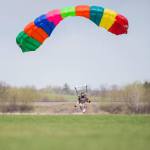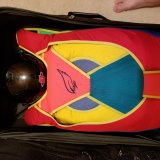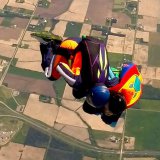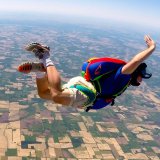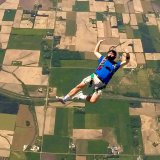-
Content
148 -
Joined
-
Last visited
-
Feedback
N/A
Content Type
Profiles
Forums
Calendar
Dropzones
Gear
Articles
Fatalities
Stolen
Indoor
Help
Downloads
Gallery
Blogs
Store
Videos
Classifieds
Everything posted by AtrusBatleth
-
I'm no canopy expert, I just jump an S-Fire as a beginner. I think "square" and "eliptical" are relative terms. I've seen plenty of obviously elliptical canopies of other jumpers (both front and rear edges are curved). The S-Fire I jump looks pretty square in comparison, but I suppose it curves a tiny bit. I could have sworn it was marketed as a "semi-eliptical" when I bought it but I agree, their website now calls it elliptical. Anyway, my opinion is if the manufacturers are saying it is a beginner/intermediate canopy it's probably going to behave pretty tame regardless of whether it's called square or elliptical. PS - NZ Aerosports and Icarus Spain both manufactured Saffire-2 canopies for some time, then they had some kind of falling out over royalty payments or legal issues. NZ Aerosports came out with Saffire-3, and Icarus Spain came out with S-Fire. Sortof like how there was a family squabble that split the founding midwest farm equipment business into Blains Farm & Fleet vs. Mills Fleet Farm. Max Peck What's the point of having top secret code names, fellas, if we ain't gonna use 'em?
-
Tunnel can definitely be harder due to how long you go. Skydiving freefall is only 1 minute at a time, with a long break between jumps. I used a tunnel to help me through AFF when I was getting stuck with being stable and not spinning. It helped a lot because I could take the time to really get used to the feel and how body movements made me move without being interrupted by that pesky parachute business. But after 15 minutes (in 2.5 minute rotations) I was EXHAUSTED. You definitely work your muscles in freefall, and any kind of strength training or exercise in general will help you do better in the tunnel. As for balancing the risk with family, I'm there with you. I've got young kids but thankfully my wonderful wife understood what a passion this activity was for me and has been very supportive. The risk is definitely real. If you take the USPA statistics per year and carry it through assuming a 30 year duration in the sport (which was a reasonable guess in my case), it works out to a 2% risk of fatality sometime in your skydiving career. That made me seriously pause and reconsider, because it's very important to me that my kids have their father and my wife has her husband. I decided to go ahead and do AFF (1 year in the sport is much less risk than 30) and reevaluate as I go. I've read hundreds of incident reports, studied the statistics, etc. Ultimately I concluded what has already been mentioned: there are a lot of choices under my control that can substantially reduce that risk. I'm not interested in swooping or high performance landings, not interested in wingsuits or CReW, jump a large canopy, AAD, RSL, etc. I take it very conservatively. For some that just wouldn't be as much fun, but personally I am completely content "merely" jumping out of a plane on a regular basis. Max Peck What's the point of having top secret code names, fellas, if we ain't gonna use 'em?
-
I am absolutely loving the Netflix series Travelers. Very interesting time travel story. And I was pleasantly surprised to see some skydiving featured in episode 207, "17 Minutes". If you have Netflix, you should check it out. With that said, I had a few smack-my-head moments. *SPOILER ALERT* - I actually don't think this really spoils anything integral to the plot, but just throwing this out anyway. First off, the whole yelling at another jumper in freefall. At least they didn't carry on a conversation like other movies have done, and it was just a one time "you ok?" so you could pass it off as the guy yelling to himself. Plus I've pretty much resigned myself to movies always portraying talking in freefall, like how there's always sound effects in space. Eh, it's entertainment. But then the guy on the ground is yelling at a falling jumper to pull their chute. And he was not speaking out-loud to himself out of desperation, he was clearly yelling at the jumper as if they could hear him. I couldn't help laughing at that. Next, apparently they weren't jumping with AADs. I know not everybody does, but it's a pretty damn high percentage that do. They didn't even need a no-out for the story to kill the jumper, because... They had an unconscious jumper with the main deployed and the guy on the ground was worried about him because he was spiraling down and was still going to get killed. I know it's a little thing, but I was impressed with this detail making it into the story. Usually in the movies a skydiver is going to die because their parachute doesn't open, but here it was accurately portrayed that having a spinning canopy can be just as deadly. I even appreciated the video footage of a rough landing, giving some wuffos out there a little first person perspective of just how fast you can be coming in on landing. I'm a little skeptical about the whole making a phone call under canopy, visor down and wearing gloves. I realize she could have had a bluetooth earpiece, and a nice helmet that doesn't fog up under canopy like mine does. and wearing gloves that have the touchscreen fingertips... but seriously how many jumpers jump like this? Does any skydiver out making a casual jump rig themselves in case they need to make a phone call under canopy? On the other hand, I thought it was pretty cool how the phone was mounted on her arm like that. Again, do normal jumpers actually do that? Are they using altimeter apps or using their phone GPS to track their aerial trajectory? Perhaps I'm just not that cool. Side note; as decked out with fancy gadgets as this jumper was, it seemed a little out of place to have a single old-school analog altimeter, but maybe she had multiple audibles to back that up. My final observation was the complete lack of anybody at the DZ. There's just 2 jumpers and their 1 friend on the ground, waiting by his car at the edge of the landing field. NOBODY else is around for miles. And they jumped out of a reasonably large twin engine craft. I'm not sure if it was a twin otter, but the point is it was definitely not a 182. I could maybe believe these jumpers had a friend pilot with a small Cessna and this was a private jump, but a frickin twin engine plane? They obviously were not jumping at a commercial DZ, and had nobody else on the load with them. What the hell? Anyway, despite my nitpicking these few things, I thought it was pretty well done. Kudos to the jumpers that helped film these shots, and it was an awesome episode and I highly recommend the series, if you like sci-fi time traveling type shows. Max Peck What's the point of having top secret code names, fellas, if we ain't gonna use 'em?
-
18882144_10210455776525057_3444431016228471289_n
AtrusBatleth posted a gallery image in Miscellaneous
-
18837024_10210453327103823_2869527579518036543_o
AtrusBatleth posted a gallery image in Miscellaneous
-
18814947_10210453323383730_4658308011395178803_o
AtrusBatleth posted a gallery image in Miscellaneous
-
Should I travel abroad for a world class AFF experience?
AtrusBatleth replied to dive42's topic in Safety and Training
In my opinion (and I am an inexperienced student so take with a grain of salt), I would recommend training closer to home even if it takes a little longer. This is assuming you have checked out your home dropzone, spoken with the instructors, and feel safe and comfortable and welcome there. If you're not comfortable training there then you should find a new home dropzone anyway. The reason I recommend the home dropzone, echoing previous comments, is that you build a relationship and familiarity (and hear some great stories and experiences) from the instructors and staff that you will probably be jumping with once you are licensed. When I started I had no idea how restrictive the winds could be for students, and have spent a lot of time on the ground waiting (even rode up on a plane only to have to ride it back down). I considered taking a week vacation and travelling somewhere to get certified in a week, but it was because of the added travel and lodging cost that I decided to stay closer to home. I don't regret my decision, even though I am waiting through off-season still unlicensed. My wife even managed to join me at the dropzone a few times while I was waiting on winds, and that went a long way in making her feel comfortable with what I was doing (just as important as feeling safe about it myself). Whatever your decision, make sure you feel safe with the dropzone you choose. Good luck (or Blue skies, whatever, some of this skydiving lingo still sounds cheesy to me). Max Peck What's the point of having top secret code names, fellas, if we ain't gonna use 'em? -
I was finally going through some of the pictures my wife took during one of her visits to the DZ and came across a pretty good shot showing what my harness looks like. This is after jumping several times and shortening the webbing, fitting about as good as I could get it. As I said, the chest strap is still coming up pretty high (the radio below my chin is rubber-banded to the chest strap), but not digging into my chin at least. Max Peck What's the point of having top secret code names, fellas, if we ain't gonna use 'em?
-
I understood the OP to be asking about being suspended in the air. With that said, I realized after posting my comment about the metal handle didn't make sense (I'm not a line worker but I do work for an electric utility and have been through some safety training). The point is, all the safety tips you hear about getting in a car accident with downed power lines still apply: if you are in a safe condition, stay there and wait for help and warn others approaching. If you must move, make sure nothing is dragging and hop or make small shuffle movements as you don't know if parts of the ground may be energized and if you take a big step with both feet on the ground the voltage may find a better path through YOU. Of course, it's best not to run into the power line in the first place. Max Peck What's the point of having top secret code names, fellas, if we ain't gonna use 'em?
-
I am, I just ask questions here in between visits to the DZ. I work in the nuclear industry and am accustomed to publishing my failings and near misses so others can benefit. Plus this forum gave me a couple ideas for questions I might not have thought to ask, so I have benefited as well. Thanks for the advice. Max Peck What's the point of having top secret code names, fellas, if we ain't gonna use 'em?
-
What I was trained, sit tight, don't touch your reserve handle if it's metal, and wait for help, but warn anyone approaching (including DZ staff) not to come close until the utility people can be called in to ensure the power is cut. Keep in mind I'm a newbie, but that means my training is fresh in my head.
-
Can you explain your body type to us? Height and weight, athletic or round etc.? a chest strap coming up to your chin is not safe in my opinion... Perhaps I should clarify the chest strap now comes up to my neck, i.e. below my chin if I point my head down. It no longer digs into my neck/jaw, but when I look down I can feel the radio on the strap by my neck (I can pin it down with my jaw). I'm not sure I understand how this is not safe. I thought the chest strap ensures the pack stays on while you pitch to a legs-down position: mission accomplished. It was the lift Web adjustment that improved the fit. I've done 6 jumps on the same harness now and the last 5 have been much better since shortening the webbing and making sure my leg straps are tight (I'm not convinced they were tight enough the 1st time, but I was too foolish to check this after landing). I might shorten the webbing a little more next time but the pack is difficult to get on my shoulders already so I can't go a lot shorter. As for my build, I'm 5'-11", 235 lb, waist size 38 or so. I'm a regular runner but I still carry some extra weight around the belly, so I would describe myself as more round than athletic (I'm working on it). My upper body somewhat resembles a linebacker (I think; I'm not big on football, but I have broad shoulders). Max Peck What's the point of having top secret code names, fellas, if we ain't gonna use 'em?
-
Cool unusual video from my dropzone in Poland
AtrusBatleth replied to skydiverek's topic in General Skydiving Discussions
I like the song, but I am also confused why it is so common in skydiving videos. The song is called Sail, says maybe he should kill himself, has ADD (I think whoever wrote the lyrics had ADD ). But whatever. Cool video, thanks for sharing. Max Peck What's the point of having top secret code names, fellas, if we ain't gonna use 'em? -
I must confess something about the gloves that I'm not proud of. I was at the DZ the previous day and got bit by something on my pinky finger (maybe spider, never confirmed). My finger swelled up for a few hours, throbbing pain, couldn't make a fist. I was grounded due to winds anyway but I would not have jumped in that condition. Next day, the finger felt fine except when it got cold (washing my hands, car vent, etc) a sharp pain would return. I convinced myself it was good enough, but when hearing it was a little cold at altitude I asked for gloves. I was concerned the cold air during free fall would bring back the sharp pain and I would fumble throwing my pilot chute or gripping the toggles (it was my right hand). If I was that concerned about my hand I should have stayed on the ground. As for the other gear, I have since jumped with a different helmet that only covers the top half of my head, fits better and improves visibility. I was able to get my harness better adjusted with my instructors help so I can move my head. The chest strap still comes up to my chin and it's not a comfortable canopy ride, but at least it is functional and safe, and there's not much more adjustment that can be made on this student harness for my body shape. I don't jump with gloves anymore. I don't recall on the first canopy flight if I could see my EP handles, but I know when I considered it I felt for them to reassure myself. They taught me the grab with 2 hands method, but if I didn't feel comfortable seeing the reserve cord I would have put one hand on each and then pulled (keep in mind there is also the RSL). I'm just trying to say if there had been some other malfunction and I was in a hard turn I am confident I could have done EP even if blind. Also I was altitude aware the entire time. Max Peck What's the point of having top secret code names, fellas, if we ain't gonna use 'em?
-
Yes, he thought it was loose leg straps (as said in the post). At the time, I was happy with the gear. It was my first time wearing my own parachute and I guess I didn't appreciate what could happen if it wasn't fitted properly. I definitely will be checking the fit more before I am happy with the gear next time.
-
I'll second the comment that if you want to know more, ask. I would expect them to have some kind of cutaway practice handles (though not necessarily suspended). It really helped me to understand the rig when I learned how to pack a parachute. At my DZ this is taught as a separate ground class; not sure how yours will be setup.
-
I honestly have no idea. I was too preoccupied with deflating my canopy, not dragging my canopy, and not getting runover by a plane. Oh, and thankful I didn't land in a corn field or break my ankles. My instructor helped me out of my harness before I thought to compare how the legs felt, and I was just happy to get that wretched helmet off my head.
-
Yes, this sounds exactly like what happened to me! Of course I don't know which part is the yoke or main lift webs. I thought the legs and chest were the only things to adjust. I'll have to ask about this next time I'm at the DZ. I think I'll have to use the same harness to get the 0.8 ratio they want for students (and I'm not even meeting that), so I'll have to get more familiar with adjusting it.
-
I thought I would share my experience because I have not read of this happening to anyone else (maybe I'm just not searching well enough). I am new to this sport, with only 3 tandems and 1 jump on my own gear (AFP Level 1). I will not be offended if you tell me I did something extremely stupid. I'm trying to learn from my mistakes. On my AFP Level 1 jump I was wearing a 270 harness (I weigh 235), jumpsuit, thick gloves (it was reported to be pretty cold at altitude), and a student helmet that covered my ears. The helmet was a rather tight fit and restricted my field of view but it was the only style I could find. My instructor helped me put on my pack and checked my harness, after which he did tighten the leg straps. I was told to thread my chest strap which I did, then my instructor said it was too tight. Evidently, my leg straps were still too loose but I did not realize this and it was not noticed on the ground or in the plane (or they came loose during free fall, which I was told can happen sometimes). I had a very uneventful free fall and pulled at 5500 ft as planned. I felt my canopy deploy right away, and I proceeded to start my 4S check (Square, Straight lines, Slider down, Steerability). Unfortunately I could not move my head. My helmet felt as if it were locked in place, unable to move it up, down, or even side to side. My chin strap was digging into me quite a bit tighter then I remember when putting it on. No matter how much I strained, I could not move my head to look up, so I could not see the canopy, slider, lines, or toggles. The helmet was blocking my field of view so I essentially had tunnel vision. When I tried to look up I could feel my helmet hitting a solid wall behind me which I assume was my container. After a brief panic and mental expletives, I checked altitude and was somewhere around 4000 ft. I had time. I reached up and tried grabbing both risers to lift myself up, hoping to free my head enough to check the canopy, maybe even look to see what the hell had happened with my harness. It didn't work, no matter how hard I tried pulling myself up (although I can't do a pull up on the ground). While I was lifting up on the risers, I noticed myself spinning slowly and felt myself recover from a line twist. Since I could not see the lines, I had no idea I even had a line twist; fortunately it fixed itself. Since my helmet was restricting so much of my view, I decided to try to remove it. However it was cutting into my chin so much and I could not handle the strap release with the thick gloves I had on that I eventually gave up. It never occurred to me to take my gloves off, although my altimeter was secured to my finger so I don't think I would have risked dropping my altimeter to take my gloves off. I knew I had a problem, but this was not a scenario that was covered in any of my training. Every malfunction scenario assumes you can check your canopy. I was on my own. I could not verify if I had a good canopy and I started to seriously consider emergency procedures. My altitude was 3000-4000 ft, so I decided I still had time to try to fix this. I tried releasing the toggles, but since I could not see them I was trying to find them by touch. I could not find them through my gloves, and I was starting to wonder if they were too high for me to reach since my container was up behind my head. I remembered that if I had to, I could pull on the rear risers to safetly land. I sucessfully flared pulling on the rear risers, which was a huge relief to me. My altitude was still above 3000 ft, so I made another attempt to locate my toggles which was successful. Using the toggles I did another successful flare, and checked right and left turns. I was concerned that I could not look where I was turning to check for traffic since I could not move my head, and the helmet blocked my peripheral vision, so I made gentle turns just in case. It was like driving a car in the winter where you've only scraped off that little bit if ice directly in front of you due to laziness. By this time I was about 2500-3000 ft and I decided I had a good landable canopy even though I could not see any of it. By now I was starting to half hear the radio commands from my instructor, which I was grateful for. I was wishing I could radio back to tell him the problems I was having, but I did not want to risk losing my grip on my toggles to key the radio. I could not move my head enough to look straight down, so it was difficult to see exactly where I was or look to the sides for where I wanted to be. I just followed the radio guidance and checked my altitude, although I didn't make out the calls to turn left to final approach until I had overshot the landing field, so I ended up landing right at the end of the runway/taxiway, but at least I landed safely. Still, not the experience I was hoping for in my first solo canopy flight. Because I landed so far from my instructor, he didn't get a good shot of my landing. I was hoping to see from the video exactly what had happened with my harness to restrict my helmet so bad. I was told my leg straps were probably too loose or came loose during free fall which led to me sitting very low relative to my container. In hindsight, I wonder if the shoulder straps from the container had come up and snagged on the helmet pulling it up from the back. This could have been why I felt the chin strap so tight, and why my field of view was so limited above me (the helmet may have tipped forward slightly). Maybe I was even hanging a bit from my helmet chin strap. I also think the chest strap may have been up a little high, but I don't remember it cutting into my chin, then again it was a bit of a blur so maybe that was the chest strap digging into my neck and not the helmet strap. Another thing that only occurred to me later is that if I had decided to do emergency procedures it would not have made any difference, since I would have had the same harness/container position that was blocking my movement. The lesson learned, as best as I can tell as a newbie, is make sure your leg straps are tight! However, I am curious if others would have reacted differently if presented with the same problem. Has anyone else even heard of this scenario happening before?


